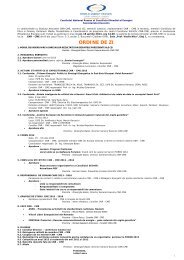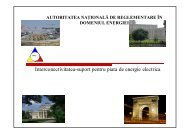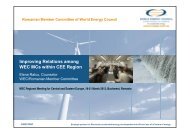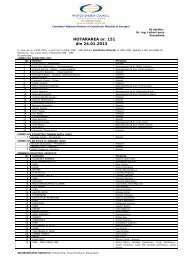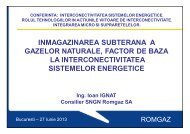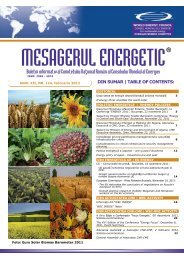Create successful ePaper yourself
Turn your PDF publications into a flip-book with our unique Google optimized e-Paper software.
substantial greenhouse gas savings<br />
(when emissions from indirect land-use<br />
change are included) should not be<br />
subsidised in the period after 2020. In<br />
the interim period, the proposal aims at<br />
stabilising the consumption of first<br />
generation biofuels.<br />
Will there be any changes for<br />
Member States?<br />
For the fulfil<strong>me</strong>nt of the 10% renewable<br />
energy target, the Member States can<br />
only count 5% biofuels from food crops.<br />
The rest needs to co<strong>me</strong> notably from<br />
advanced biofuels, like the ones made<br />
from wastes or agricultural residues<br />
such as straw, but also from the use of<br />
renewable electricity in road and rail<br />
transport.<br />
Will there be any changes to the<br />
introduction of E10 in Member<br />
States?<br />
E10 <strong>me</strong>ans blending petrol with up to<br />
10% (in volu<strong>me</strong>) of ethanol and is a<br />
<strong>me</strong>ans to achieve the 2020 targets,<br />
which remain unchanged. Ethanol can<br />
not only be produced from food crops,<br />
but also from residues. Furthermore,<br />
the best available scientific evidence on<br />
ILUC indicates that ethanol offers<br />
significant greenhouse gas savings,<br />
also when ILUC emissions are included<br />
and that the use of E10 does not<br />
contribute to dramatic increases of food<br />
prices. E10 should therefore be<br />
introduced equally across the EU<br />
without delay.<br />
Will the 5% limitation in the<br />
amount of first generation biofuels<br />
that can be counted towards the<br />
targets of the EU legislation put a<br />
limit on the production of first<br />
generation biofuels?<br />
No. The production and consumption of<br />
first generation biofuels can be higher<br />
than 5% in a given Member State, but<br />
the excess of 5% will not count towards<br />
the Member States’ renewable energy<br />
targets.<br />
Can growing use of biofuels have a<br />
negative impact on the availability and<br />
prices of food and feed in the world?<br />
All increased use of land increases the<br />
competition for the resources that we<br />
get from our land areas. This holds for<br />
crops used for biofuels, cotton used for<br />
clothes, coffee, maize used for feeding<br />
animals for <strong>me</strong>at production and palm<br />
oil used for cos<strong>me</strong>tics.<br />
Under the new rules, the growth in<br />
biofuels in the EU should co<strong>me</strong> from<br />
feedstock that are not in competition<br />
with food crops, thus minimising these<br />
impacts.<br />
How much arable land is used for<br />
growing the feedstock for biofuels?<br />
In the EU? In the world?<br />
The globe has ca 13 200 Mha of land of<br />
which about 1600 Mha is used for<br />
growing various crops. Less than 3% of<br />
global cropland is used to produce<br />
biofuels. In the EU, we use around 2%<br />
of our agricultural land for biofuels.<br />
Where are the biofuels consu<strong>me</strong>d<br />
in the EU being produced?<br />
In 2010, 83% of the biofuels consu<strong>me</strong>d<br />
in the EU were produced in the EU, part<br />
of which is produced from imported<br />
feedstock. The main countries expor ting<br />
biodiesel to the EU were Argentina, Brazil<br />
and USA for soy biodiesel and Indonesia<br />
and Malaysia for palm oil. For bioethanol,<br />
the main exporting countries were Brazil<br />
for sugarcane bioethanol and the USA for<br />
maize bioethanol.<br />
Do the new criteria apply also to<br />
imported biofuels?<br />
Yes, all the rules for greenhouse gas<br />
reporting and sustainability criteria for<br />
biofuels apply equally to biofuels<br />
produced in the EU Member States and<br />
third countries. There is therefore no<br />
discrimination.<br />
When will the new rules take<br />
effect?<br />
The new rules will take effect after the<br />
European Parlia<strong>me</strong>nt and the Council<br />
will have adopted the proposal in a codecision<br />
procedure. Member States<br />
then have to transpose the provisions<br />
into national law within one year.n<br />
www.repower.com<br />
www.cert-int.com/romania<br />
/certification-international-ro<br />
<strong>ian</strong>uarie 2013 33



